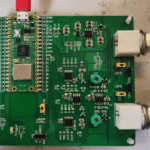In the brand new issue of HackSpace magazine, out now, we show you how to bring an old phone into the 21st century by adding a Raspberry Pi to turn it into a networked assistant.

Rotary dial phones are fashionable again. You can even buy brand new ‘old’ ones based on the original design shown in Figure 1 above. These have dials, but not the weight or the authentic bell sound. The author was completely unaware of this trend when he picked up his red phone. The idea was to retain the external appearance and behaviours but bring the device up to date with all-new internals and some fun behaviours. It seemed to him that there should be room inside for a reasonable amount of computing power, and he was keen to hear the old telephone bell sound again. He wanted to create a web-controlled device that could be used to receive messages and alerts. The telephone that was built contains a Raspberry Pi Zero 2 W running JavaScript code inside the node environment, using Express to host a telephone website. You can find all the code, 3D files for the mounting plate, and a setup sequence for a Raspberry Pi in the GitHub repository for the project.
Delving into history
The first task was to open the telephone and check the amount of space available for the new innards. Figure 2 shows the printed circuit board (PCB) inside the phone. This design was one of the first times a PCB had been used in a UK telephone.

The author would have liked to have kept the internal components in place so that the phone could be returned to its original state if required. Unfortunately, this turned out to be impossible.
Wiping the slate clean
The circuit board was cleared of components, and a 3D-printed holder for the Raspberry Pi Zero with prototyping board was inserted into the space, as shown in Figure 3, below. The phone will use a 12-volt power supply, and it was found that a power supply socket fits into the cord holder for the exchange connection with an appropriate washer.

Figure 4, below, shows the circuit for the telephone. The two devices in the centre are two ‘buck converters’. The one on the left converts the 12-volt power input into 35 volts to power the bell. The second converts 12 volts into 5 volts to power the Raspberry Pi. The handset switch is connected to the handset cradle and indicates whether the handset is on the phone. The dial pulse and dial active switches are in the telephone dial, of which more later.

Ring the bell
The bell in the telephone was originally driven by two coils powered by a 75-volt alternating current signal with a frequency of around 18Hz. The coils move a bell-clapper left and right between two metal bells tuned to different musical notes. The author was very keen to retain the distinctive ring, but less keen on getting 75 volts up his armpits when assembling the phone. So, rather than using 75 volts AC, he opted to use a much less tingly 35-volt supply, using software to drive each coil in turn. Two MOSFET controllers were used, one for each bell. These are connected to general-purpose input/output (GPIO) pins on the Raspberry Pi which are controlled by JavaScript running the phone.

HackSpace magazine issue 73 out NOW!
Read the full tutorial when the free PDF version of the latest issue becomes available on December 14th.
Each month, HackSpace magazine brings you the best projects, tips, tricks and tutorials from the makersphere. You can get HackSpace from the Raspberry Pi Press online store or your local newsagents.








